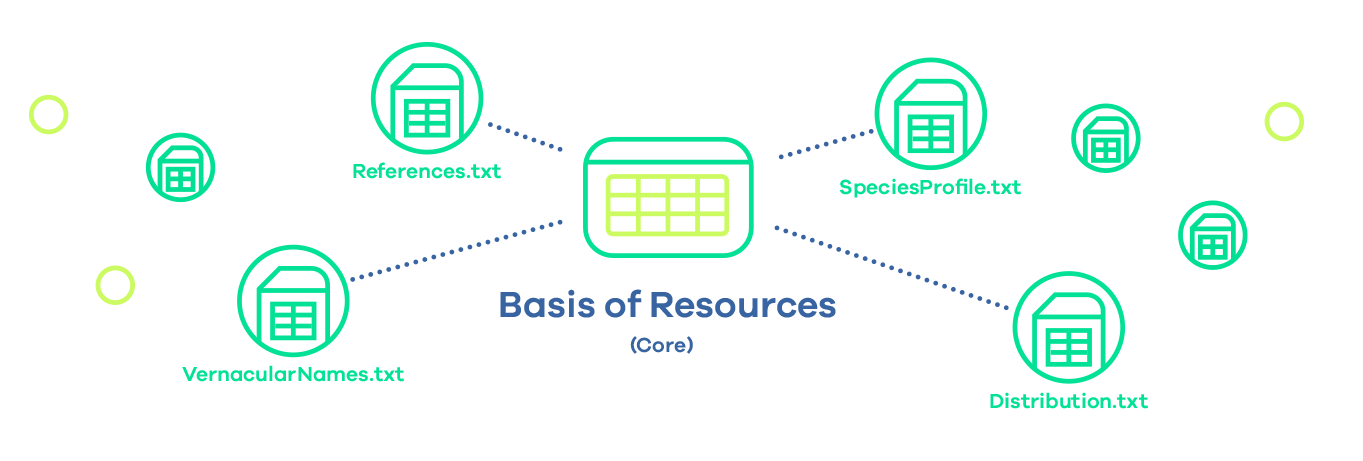Publication Guide
This guide aims to help you clear up your doubts regarding the publication of data through the GBIF network.
Publication consists of sharing your biodiversity data with the world through our platform, with globally accepted standards, offering free access and use in accordance with established use licenses. In this context, data providers have full control over what information to share and how to do it.
- Register with GBIF
- Adapts data to the Darwin Core standard
- Validate the data
- Upload your data online
- Prepare the metadata
- Publish the resource and notify GBIF.ES
- View the data
Register with GBIF
Formally register your institution and the biological collections/databases it includes. By completing the following forms you will become part of the GBIF collection registry and network of publishers.
Adapts data to the Darwin Core standard
Formally register your institution and the biological collections/databases it includes. By completing the following forms you will become part of the GBIF collection registry and network of publishers.
GBIF supports four classes of data sets, but in order for them to be shared on the GBIF network they must adapt to the Darwin Core standard.
What is Darwin Core?
Darwin Core (DwC) is a common language designed to facilitate the exchange of primary biodiversity data globally. This standard works as a reference model that aims to integrate information from different sources and share it in a homogeneous way that can be understood and used by everyone.
It consists of a set of 169 terms (which can be understood as “fields”, “attributes” or “headings”) that cover aspects related to taxa and their presence in nature. The standard additionally has 23 thematic extension packages, which provide additional terms to complement information that is not available as core elements of the standard (measurements, vernacular names, etc.).

What does adaptation to the standard consist of?
It consists of making a correspondence between the fields (columns) of your database and those of the Darwin Core standard. If when you identify the terms you don't see where you can include your information, review the available Darwin Core extensions that expand the capabilities of the standard..
What data can be published in GBIF?
There are four types of data sets that can be published through GBIF. They are simple in their essence, but they can be enriched and made more complex and better structured within the network framework with the use of information extensions.
Biological records or presence data (Occurrences) - They inform about the location of organisms in time and space. They include, for example, specimens and fossils in natural history collections, observations in the field, etc.
Species lists (Checklist) - These are compilations of scientific names or taxa that may be restricted to a taxonomic group, geographic region, specific topic (invasive species, red lists, etc.) or a combination of the three.
Sampling events - These data sets are typically produced through standardized biodiversity measurement and monitoring protocols such as vegetation transects, bird surveys, and marine or freshwater sampling. They indicate the methods, events, and relative abundance of the species recorded in a sampling.

Download the Excel/Access templates here with the terms of the DwC standard, choosing the type of data you want to share
Download here some of the templates with the most used extensions
Access the guide with DwC terms here
Validate the data
This process consists of verifying and adjusting the contents in accordance with the definitions and quality criteria established by the standard. For this, you can help yourself with the resources in the tools section.
Upload your data online
Upload your data online through the publishing platform (IPT), using the assigned credentials. If you don't have them yet, request them by sending an email to info@gbif.es
What is the IPT?
The IPT (Integrated Publishing Toolkit) is a web application developed by GBIF to facilitate the publication of biodiversity resources through the Internet. This tool allows the integration of the file adapted to the Darwin Core standard in different formats (Microsoft Excel spreadsheets, text files, etc.) and easily fills in the metadata that will accompany it.
Prepare the metadata
Metadata (literally "data about the data") is an essential component in the GBIF network, as it describes aspects such as the "who, what, where, when and how" of a data set, in a way that allows you to the user to know their context and understand how suitable they are for a specific use.
Enter your metadata through the IPT platform using intuitive forms adapted to the GBIF Metadata Profile (GMP). In the GMP there is a minimum set of required elements, but it is recommended that you fill in as much information as possible to ensure that the metadata is sufficiently descriptive and complete.
Publish the resource and notify GBIF.ES
Once the data and metadata are correctly uploaded, you can publish from the IPT platform. Automatically, a “Darwin Core File” (DwC-A) will be generated that contains your data and metadata, and is suitable for sharing on the GBIF network. Finish the process by notifying the publication to the email ipt@gbif.es.
Before officially registering the data on the GBIF portal and making it accessible for consultation, the IPT administrator will carry out a review and quality control.
View the data
Once the process is complete, you will receive an email with the links of your collection to the GBIF national and international data portal.







